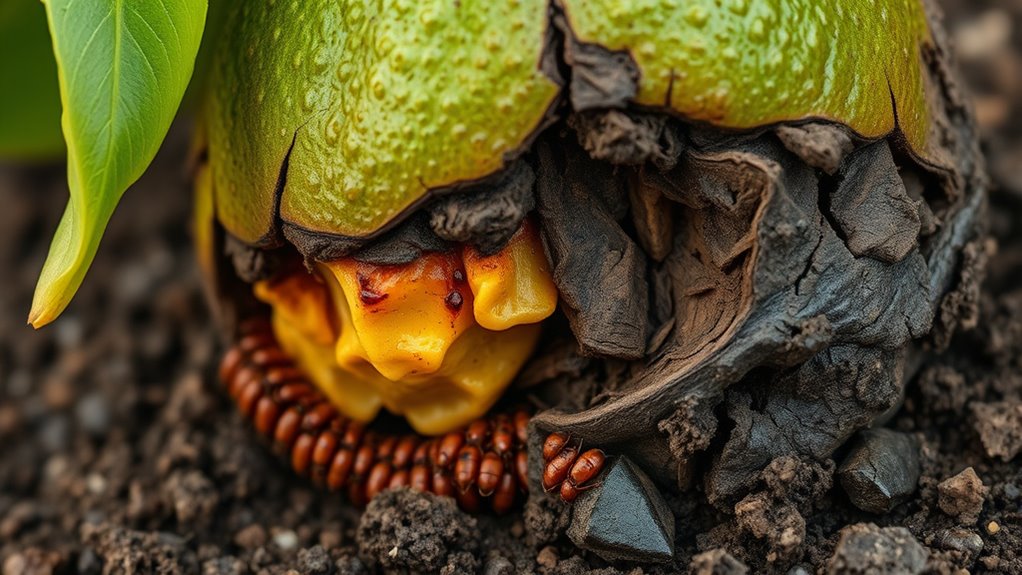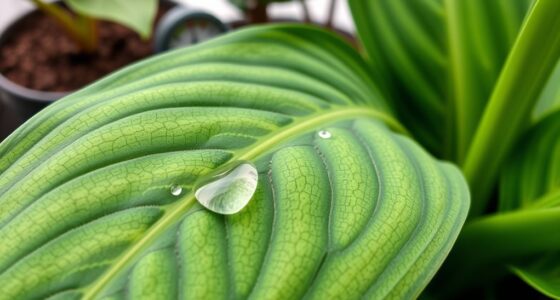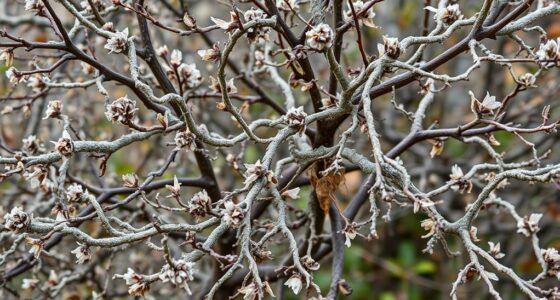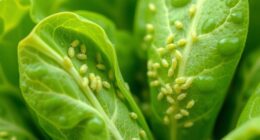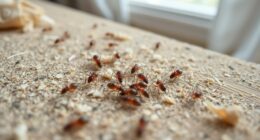If your avocado root is turning brown, it could be due to waterlogged soil, root rot, or pests. Waterlogging leaves roots deprived of oxygen, causing decay, while fungal infections create mushy, discolored roots with a foul smell. Pests can also cause damage, leading to browning and wilting. To protect your plant, check soil moisture, look for signs of rot, and inspect for pests. Keep going to learn how to identify and fix each issue effectively.
Key Takeaways
- Waterlogged soil causes roots to turn brown due to lack of oxygen and root suffocation.
- Root rot presents as dark, mushy roots with a foul smell, indicating decay from overwatering.
- Pests like borers or mites can damage roots, leading to discoloration and browning.
- Nutrient deficiencies typically cause yellowing, not browning, and are less associated with root decay.
- Proper drainage, pest control, and soil health management help distinguish and address the root issue.
Recognizing Signs of Waterlogging and Overwatering
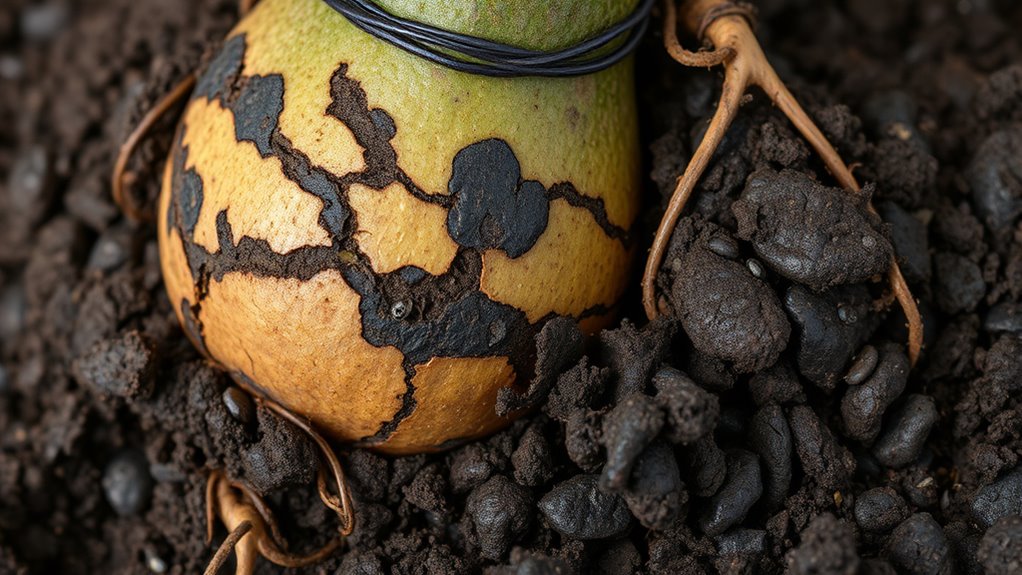
Waterlogging and overwatering are common causes of avocado root browning, and recognizing their signs early can save your plant. One key indicator is poor soil aeration; when the soil stays too wet, it becomes compacted, limiting oxygen to the roots. Check the moisture levels regularly—if the soil feels constantly soggy or if water pools on the surface after watering, you’re overwatering. You might also notice yellowing leaves, wilting, or a foul smell from the soil, all signs of excess moisture. Keep an eye on how often you water and ensure the soil drains well. Proper soil aeration helps roots breathe and prevents water from lingering too long. Adjust your watering habits accordingly to maintain ideal moisture levels and protect your avocado’s health. Additionally, understanding the role of contrast ratio can help you evaluate soil conditions more effectively when choosing soil amendments or drainage solutions. Monitoring soil drainage capacity is essential for preventing waterlogging and ensuring healthy root development.
Identifying Root Rot and Fungal Infections
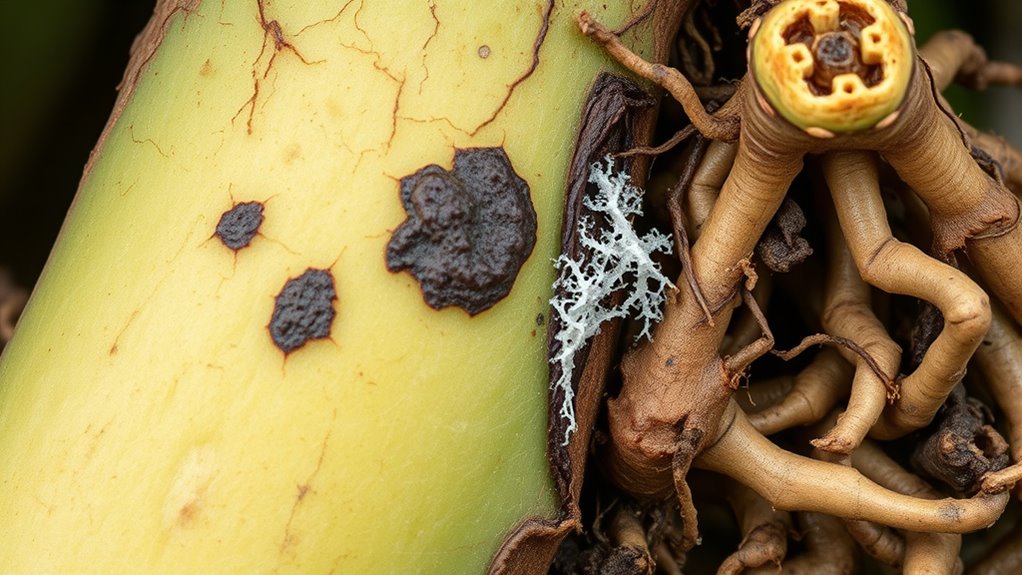
Because root rot and fungal infections often develop subtly, it’s important to regularly inspect your avocado’s roots and soil for signs of trouble. Look for dark, mushy roots or a foul smell, which indicate decay. Fungal infections thrive in poorly aerated soil, so check soil aeration levels—compacted soil can trap excess moisture and promote fungi. Improving soil drainage by adding organic amendments, like compost or aged mulch, helps prevent fungal growth and promotes healthy root development. Keep an eye out for discolored roots or roots that easily break when touched. If you notice these signs, it’s vital to act quickly to remove affected roots and improve soil conditions. Proper soil aeration combined with organic amendments can greatly reduce the risk of root rot and fungal infections. Additionally, understanding soil health and maintaining proper watering practices can further protect your avocado from these issues.
Detecting Pest Infestations and Damage
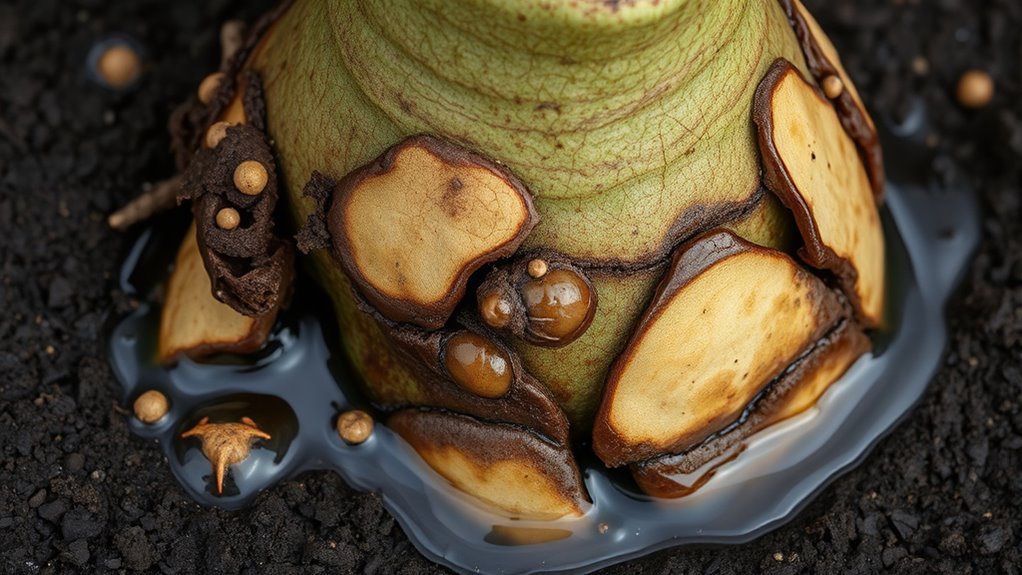
Pest infestations can quickly damage your avocado tree if left unnoticed, so regularly inspecting your plant for signs of pests is essential. Look for disease symptoms like chewed leaves, sticky residue, or webbing, which indicate pest activity. Check the undersides of leaves and stems, as many pests hide there. Discolored or wilting foliage can also signal pest damage. Early detection helps you take prompt pest control measures, preventing pests from spreading or causing severe harm. Use a gentle spray of insecticidal soap or horticultural oil to manage infestations effectively. Maintaining good hygiene around your tree and removing fallen debris also supports pest control. Additionally, understanding the types of pests that commonly affect avocado trees can help you identify specific issues early. Regularly inspecting for pest hiding spots allows for more effective treatment and reduces the likelihood of widespread damage. Being aware of how pest infestations can contribute to root rot and other problems emphasizes the importance of prompt action. Remember, catching pest issues early keeps your avocado healthy and prevents brown root tips linked to pest-related stress.
Differentiating Between Nutrient Deficiencies and Other Causes
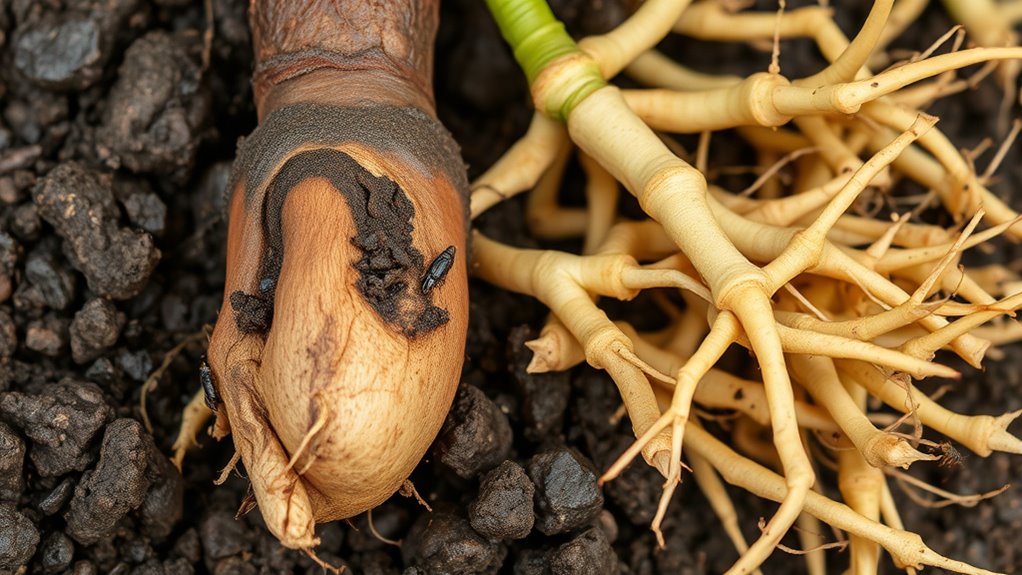
To accurately identify the cause of browning roots in your avocado tree, it’s important to distinguish between nutrient deficiencies and other issues like root rot or environmental stress. Nutrient imbalance, such as insufficient nitrogen or magnesium, often causes yellowing or browning leaves, but roots may appear weak and discolored. Soil testing helps determine if nutrient levels are low or imbalanced. Watch for signs like uniform browning (common in deficiencies) versus localized rot or blackened roots (indicating rot). Here’s a quick comparison:
| Cause | Symptoms |
|---|---|
| Nutrient deficiency | General yellowing, weak growth, uniform root browning |
| Root rot or rot disease | Localized blackened, mushy roots, foul smell |
| Environmental stress | Sudden browning, wilting, inconsistent pattern |
Understanding these differences will guide your next steps, especially since soil health plays a crucial role in preventing root issues. Maintaining proper watering practices and ensuring adequate drainage can help prevent waterlogging that often leads to root rot. Additionally, being aware of pest infestations can help identify other potential causes of root browning.
Effective Strategies for Treatment and Prevention
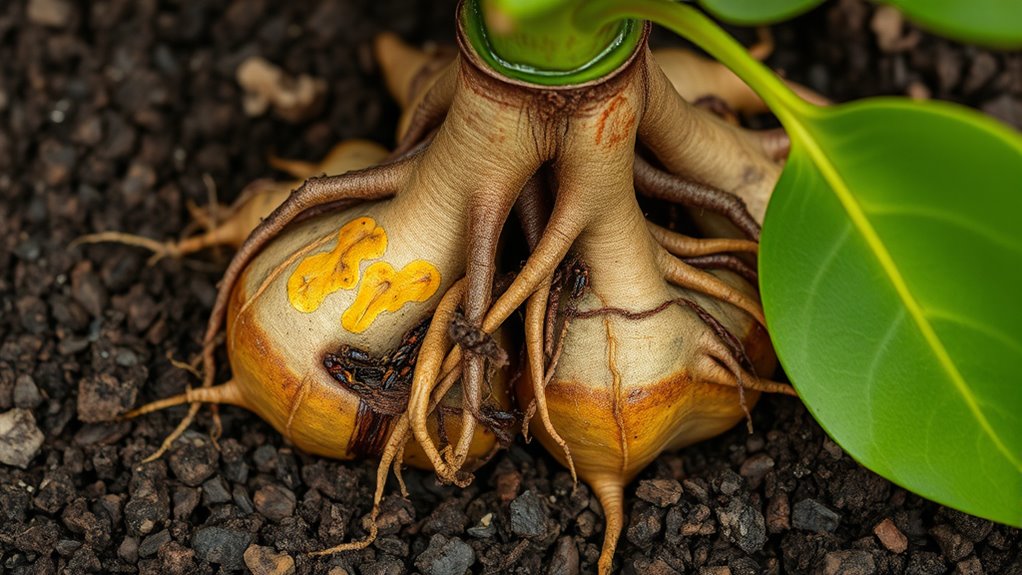
Implementing proper treatment and prevention strategies is essential for maintaining healthy avocado roots and preventing browning issues. Start by improving soil aeration to avoid waterlogging, which can suffocate roots and promote rot. Guarantee your soil drains well and consider adding organic matter to enhance airflow. Regularly check and adjust the soil’s pH balance, aiming for a slightly acidic to neutral range (around 6.0-7.0), as improper pH can hinder nutrient uptake and weaken roots. Avoid overwatering and create a consistent watering schedule that keeps the soil moist but not soggy. Mulching can help retain moisture and regulate temperature. Additionally, using diverse planters can improve drainage and airflow around your plants. Proper soil management practices are vital for preventing issues like pests and diseases that can also cause browning. For optimal root health, consider incorporating self-watering planters, which can help control moisture levels and prevent overwatering. By focusing on soil aeration and pH balance, you reduce risks related to rot, pests, and waterlogging, supporting robust root health and preventing browning.
Frequently Asked Questions
Can Environmental Stress Cause Avocado Root Browning?
Yes, environmental stress can cause avocado root browning. Poor soil drainage and inconsistent watering practices lead to waterlogged soil, which stresses roots and causes browning. When you overwater or neglect proper drainage, roots struggle to get oxygen, resulting in damage or rot. To prevent this, guarantee your soil drains well and stick to a consistent watering schedule. Proper care helps keep your avocado roots healthy and vibrant.
Are Certain Avocado Varieties More Prone to Root Problems?
Certain avocado varieties do show differences in disease susceptibility and root resistance. You might notice that some varieties are more prone to root problems like rot or pests, while others resist them better. By choosing a variety with strong root resistance, you can reduce your chances of root browning. Keep in mind, environmental factors also play a role, but selecting less susceptible varieties can give you a more resilient plant.
How Does Soil Ph Affect Avocado Root Health?
Think of soil pH as the tune that your avocado roots dance to. When soil acidity is off, it interferes with nutrient uptake, much like a bad playlist ruins a dance. Maintaining a proper pH balance ensures your roots stay healthy and strong. Aim for a slightly acidic to neutral pH, around 6-7, to keep your avocado thriving. Too acidic or alkaline soil can lead to root problems and poor growth.
What Role Do Beneficial Microbes Play in Root Health?
Beneficial microbes play a vital role in maintaining root health by promoting a balanced microbial environment. They help break down organic matter, improve nutrient availability, and suppress harmful pathogens. You can support this by adding soil amendments that boost microbial diversity, ensuring a healthy microbial balance. This helps your avocado roots stay strong, resist diseases, and thrive in ideal conditions, reducing issues like waterlogging or rot.
Can Pruning Help Prevent Root Browning?
Think of pruning as tending a garden of the soul. By using proper pruning techniques and root trimming, you can help prevent root browning. Regularly removing damaged or diseased roots improves airflow and reduces stress on the plant. This proactive approach encourages healthy growth, much like pruning away doubts allows your spirit to flourish. So, yes, strategic pruning supports root health and wards off browning.
Conclusion
While brown roots might signal waterlogging or pests, they also hint at nutrient deficiencies or fungal threats. Think of your avocado’s roots as a delicate balance—too much water drowns, too little leaves it vulnerable. By understanding these signs, you can prevent damage and promote healthy growth. Just as a well-tuned instrument produces beautiful music, proper care transforms a struggling avocado into a thriving, vibrant plant. Stay attentive, and your tree will flourish.
